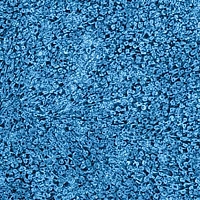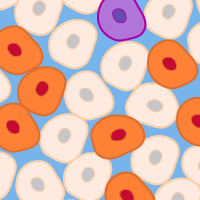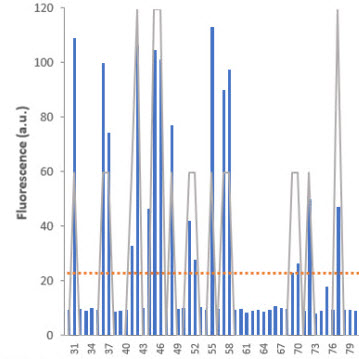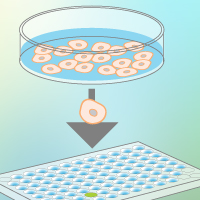Zooming in: a new hiPSC model for type 2 diabetes in a predisposed population

Type 2 diabetes (T2D), a complex, polygenic condition affecting 1 in 8 adults globally, needs relevant model systems for researchers to study pathogenesis and develop targeted therapies. Historically, animal disease models were used to explore molecular mechanisms and validate new treatments. But animal models available for T2D have important limitations (Al-awar, 2016; Franco, 2021), and the value of animal models to predict human outcomes is being challenged (Mak, 2014). Primary pancreatic islets of Langerhans are used for diabetes modeling, but these are a nonrenewable source from donors of different genetic backgrounds, adding variability to cellular models and assays.
Human induced pluripotent stem cell (hiPSC) technology has revolutionized the field of in vitro disease modeling, increasing our understanding of complex diseases such as Alzheimer’s and opening new avenues for treatments (Engle, 2018; Penney, 2020). In T2D, pancreatic beta-like cells derived from hiPSCs can provide the ideal model system.
Some genetic loci associated with T2D are unique to specific populations: variations in TCF7L2 have a strong effect in several ethnic groups, while variations in intron 15 of KCNQ1, an imprinted gene, have a particularly strong parent-of-origin effect in Southwestern American Indians. Here, we spotlight how Nair et al. (2022) created hiPSCs from three Southwestern American Indian individuals with T2D, with the goal of mimicking genetic architecture and methylation pattern in a challenging T2D-associated locus and studying its effect on pancreatic-islet cell development and function.
Generating hiPSC models that better reflect disease systems
Modeling the KCNQ1 locus presents several challenges. It has many noncoding variants linked to the lead variant, making it difficult to confirm the causal variant for the observed functional effects. It requires multiple edits in the same cell lines, and using CRISPR-Cas9 to edit noncoding variants is particularly difficult. Another challenge is ensuring comparable methylation at the regulatory regions of the KCNQ1 locus during single-cell cloning.
To understand how variations at the KCNQ1 locus affect T2D specifically in Southwestern American Indians, Nair et al. derived hiPSC lines from Southwestern American Indian patients with T2D to reflect the same genomic background. Using allele-specific guide RNA and CRISPR to target the imprinted KCNQ1 locus, the researchers generated pancreatic beta-like cells differing only at the SNPs of interest. The putative functional variants lacked CRISPR-induced genomic abnormalities and had proper methylation status.
The authors demonstrated: 1) the intronic region in KCNQ1 containing the T2D- and insulin-secretion-associated variants is potentially important for islet development, and 2) the feasibility of using their edited isogenic hiPSC lines to study the effects of the KCNQ1 variants on islet cell development and function.
Patient-derived hiPSCs: a giant leap toward developing targeted therapies
Medical research relies on having appropriate model systems to study disease states and develop therapies. To demonstrate relevant degenerative mechanisms, in vitro disease models are established from patient-specific tissue. Here, Nair et al. took it a step further: they edited hiPSCs derived from patients diagnosed with T2D to generate a more realistic disease model, demonstrating the successful use of patient-derived, edited hiPSCs to study disease-relevant mutations.
Check out the links below to learn about our products for sgRNA generation, hiPSC editing, and hiPSC single-cell cloning using the Cellartis DEF-CS 500 Culture System.
References:
Al-awar, et al. Experimental diabetes mellitus in different animal models. Journal of Diabetes Research 2016, 9051426 (2016).
Engle S. J. et al. Best practices for translational disease modeling using human iPSC-derived neurons. Neuron 100, 783–797 (2018).
Franco, et al. Assessing scientific soundness and translational value of animal studies on DPP4 inhibitors for treating Type 2 Diabetes Mellitus. Biology 10, 155 (2021).
Mak, I. W. Y. et al. Lost in translation: animal models and clinical trials in cancer treatment. Am J Transl Res. 6, 114–11 (2014).
Nair, A.K. et al. Generation of isogenic hiPSCs with targeted edits at multiple intronic SNPs to study the effects of the Type 2 Diabetes associated KCNQ1 locus in American Indians. Cells 11, 1446 (2022).
Penney, J. et al. Modeling Alzheimer’s disease with iPSC-derived brain cells. Mol Psychiatry 25, 148–167 (2020).
Takara Bio USA, Inc.
United States/Canada: +1.800.662.2566 • Asia Pacific: +1.650.919.7300 • Europe: +33.(0)1.3904.6880 • Japan: +81.(0)77.565.6999
FOR RESEARCH USE ONLY. NOT FOR USE IN DIAGNOSTIC PROCEDURES. © 2025 Takara Bio Inc. All Rights Reserved. All trademarks are the property of Takara Bio Inc. or its affiliate(s) in the U.S. and/or other countries or their respective owners. Certain trademarks may not be registered in all jurisdictions. Additional product, intellectual property, and restricted use information is available at takarabio.com.








